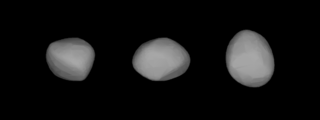Related Research Articles

Alkeste is a main-belt asteroid, and it is an S-type (silicaceous) in composition. C.H.F. Peters discovered the asteroid on August 23, 1872, from the observatory at Hamilton College, New York State. The name was chosen by Adelinde Weiss, wife of the astronomer Edmund Weiss, and refers to Alcestis, a woman in Greek mythology.

165 Loreley is a main-belt asteroid that was discovered by C. H. F. Peters on August 9, 1876, in Clinton, New York and named after the Lorelei, a figure in German folklore.

196 Philomela is a large and bright main-belt asteroid. It is an S-type asteroid.

Bianca is a sizeable Main belt asteroid. It is an S-type asteroid. It was discovered by Johann Palisa on 4 September 1880, in Pola and was named after the Austro-Hungarian opera singer Bianca Bianchi. The Vienna newspapers contained several published accounts of the circumstances surrounding the honor extended to the diva in Spring 1882. In the late 1990s, a network of astronomers worldwide gathered lightcurve data that was ultimately used to derive the spin states and shape models of ten new asteroids, including (218) Bianca. The shape model for this asteroid is asymmetrical.

Augusta is a main-belt asteroid, discovered on 31 March 1886 by astronomer Johann Palisa at Vienna Observatory, Austria. The stony S-type asteroid measures about 12 kilometers in diameter. It is the first-numbered member of the Augusta family, after which the small Asteroid family and subgroup of the main-belt has been named. Augusta was named after the German–Austrian writer Auguste von Littrow (1819–1890), widow of astronomer Carl Ludwig von Littrow, who was a former director of the Vienna Observatory.

Dresda is a typical Main belt asteroid. It belongs to the Koronis family of asteroids.

Unitas is a typical main belt asteroid that was discovered by Elia Millosevich on 1 March 1891 in Rome. The asteroid was named by the director of the Modena Observatory in honor of the Italian astronomer Angelo Secchi and the unification of Italy. It is classified as an S-type asteroid.

Laura is Main-belt asteroid discovered on 9 January 1901 by Max Wolf at Heidelberg. The semi-major axis of the orbit of 467 Laura lies just inside the 7/3 Kirkwood gap, located at 2.95 AU. It's named after the character Laura from Amilcare Ponchielli's opera La Gioconda.
Kilia is a 27 km main-belt asteroid discovered on 21 April 1901 by Luigi Carnera at Heidelberg, the 470th asteroid discovered. It was one of the 16 asteroid discoveries made by Carnera.

Papagena is an asteroid that was discovered by German astronomer Max Wolf on 7 June 1901. Its provisional name was 1901 GN.
Nolli is a rather small asteroid that may be in the Eunomia family. It was discovered by Max Wolf on February 13, 1901, but only observed for 1 month so it became a lost asteroid for many decades. It was recovered in 1987, 86 years after its discovery.
Prudentia is a Main-belt asteroid discovered on 13 February 1901 by Max Wolf at Heidelberg.
Ocllo is a large Mars-crossing asteroid. It was discovered by American astronomer DeLisle Stewart on August 14, 1901 and was assigned a provisional name of 1901 HN.
Hedwig is a main-belt asteroid discovered on August 17, 1901, by Luigi Carnera at Heidelberg. Named in honour of the wife of Swedish-Danish astronomer Elis Strömgren.
Italia is a main-belt asteroid that was discovered on 23 August 1901 by Italian astronomer Luigi Carnera at Heidelberg.
Caprera is a minor planet orbiting the Sun.
668 Dora is an asteroid orbiting in the asteroid belt located roughly between the orbits of the planets Mars and Jupiter. The name may have been inspired by the asteroid's provisional designation 1908 DO.

776 Berbericia is a minor planet orbiting the Sun. A main-belt C-type asteroid, it was discovered on 24 January 1914 by astronomer Adam Massinger at Heidelberg Observatory in southwest Germany. It was named by Max Wolf in honor of Adolf Berberich (1861–1920), a German astronomer. The spectra of the asteroid displays evidence of aqueous alteration.

852 Wladilena is a Phocaea asteroid from the inner region of the asteroid belt. It is named after the Russian Communist leader Vladimir Lenin.
962 Aslög is a minor planet orbiting the Sun that was discovered by German astronomer Karl Wilhelm Reinmuth on 25 October 1921. Measurements of the lightcurve made in 2010 and 2011 give a rotation period of 5.465 ± 0.01 hours. It has a diameter of 39.5 km (24.5 mi).
References
- 1 2 "465 Alekto". JPL Small-Body Database . Jet Propulsion Laboratory. SPK-ID: 465 . Retrieved 10 May 2016.
- ↑ 'Alecto' in Noah Webster (1884) A Practical Dictionary of the English Language
- ↑ "HEC: Exoplanets Calculator". Planetary Habitability Laboratory. University of Puerto Rico at Arecibo. Archived from the original on 24 August 2017. Retrieved 26 November 2015.